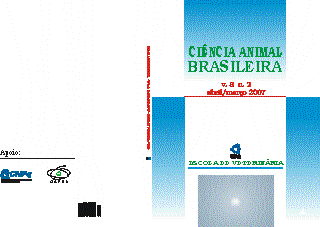SOYBEAN HULLS FED TO FEEDLOT LAMBS: PERFORMANCE AND CARCASS CHARACTERISTICS
Keywords:
Resíduos agrícolas, Nutrição animalAbstract
Sixty Santa Ines ram lambs (16.4 kg BW and 67 days old) were used to evaluate the replacement of sugar cane bagasse (SB) by soybean hulls (SH) as NDF source on performance and carcass characteristics. The trial was conduced on a factorial arrangement 2 x 2 + 1 (two NDF sources: SB and SH, two NDF level: 14% and 18% and a control treatment containing 100% of concentrate), in a complete randomized block design, with five treatments and six replications. Animals on SH diets had higher ave-rage daily gain (P=0.07) than animals on SB. Diets con-taining fiber sources (SB or SH) had higher dry matter intake (PV 0.75) (P=0.09) compared to 100% concentrate diet. There was no difference (P>0.10) on feed conver-sion, carcass chilling losses, ribeye area and fat thickness. An interaction (P≤0.07) among NDF source and level was observed for the hot and cold carcasses yields. Soybean hulls improved performance when compared to sugar cane bagasse and can be used as the only fiber source in high concentrate diets for feedlot lambs.
KEY-WORDS: Feedlot, fiber, high concentrate diets, sheep.
Downloads
Downloads
Published
How to Cite
Issue
Section
License
Copyright (c) 2007 Brazilian Animal Science/ Ciência Animal Brasileira

This work is licensed under a Creative Commons Attribution 4.0 International License.
Authors who publish with this journal agree to the following terms:
- Authors retain copyright and grant the journal right of first publication with the work simultaneously licensed under a Creative Commons Attribution License that allows others to share the work with an acknowledgement of the work's authorship and initial publication in this journal.
- Authors are able to enter into separate, additional contractual arrangements for the non-exclusive distribution of the journal's published version of the work (e.g., post it to an institutional repository or publish it in a book), with an acknowledgement of its initial publication in this journal.
- Authors are permitted and encouraged to post their work online (e.g. in institutional repositories or on their website) prior to and during the submission process, as it can lead to productive exchanges, as well as earlier and greater citation of published work (See The Effect of Open Access).




























